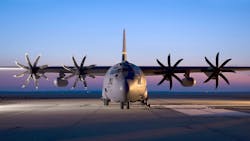Air Force picks Collins Aerospace for electronic control system of C-130 aircraft eight-blade propellers
ROBINS AIR FORCE BASE, Ga. – U.S. Air Force needed electronic control systems for the eight-blade propellers for production of the C-130J four-engine utility turboprop aircraft. They found their solution from Collins Aerospace in Windsor Locks, Conn.
Officials of the Air Force Life Cycle Management Center at Robins Air Force Base, Ga., announced a $135 million five-year contract to the Hamilton Sundstrand segment of Collins Aerospace on Friday for C-130 production.
The contract calls for Collins Aerospace to provide manufacturing and engineering support of the NP2000 eight-blade propeller, electronic propeller control system, and spare parts for Air Force C-130 production.
With its eight composite blades and the electronic propeller control system (EPCS), the NP2000 propeller systems enhances the C-130's thrust by as much as 20 percent during takeoff, reduces noise in the plane's cockpit by as much as 20 decibels, and helps reduce maintenance hours on the aircraft by as much as 50 percent, Collins officials say.
The Collins NP2000 has been in service with U.S. and international operators of the Northrop Grumman E-2 Hawkeye radar surveillance and C-2 carrier onboard delivery aircraft.
The Lockheed Martin C-130J Super Hercules is the latest and most technologically advanced version of the C-130 four-engine turboprop military transport aircraft.
Compared to the first versions of the C-130 that entered service in the mid 1950s, the C-130J has new engines, flight deck, avionics, and other systems, and is the latest in the longest continuous production run of any military aircraft in history.
The C-130J Super Hercules entered service in 1999, and can be sent on missions in harsh environments, and can touch down on austere landing strips. Versions of the plane are for combat, humanitarian, special operations, aerial refueling, firefighting, and search and rescue mission.
Related: Collins Aerospace announces new orders for C-130 NP2000 propeller system
The C-130J Super Hercules fills roles in special operations, aerial refueling, close air support, search and rescue, and personnel recovery.
Externally similar to the classic C-130, the C-130J has digital avionics with including head-up displays, Rolls-Royce AE 2100 D3 turboprop engines with composite scimitar propellers, and reduced crew requirements.
Compared to earlier version of the C-130, it has 40 percent greater range, 21 percent faster maximum speed, and 41 percent shorter takeoff distance. It comes in a standard-length or stretched variant. The plane can operate out of 2,000-foot dirt strips in high mountain ranges, transport more than 40,000 pounds of cargo and supplies.
The C-130J, which is crewed by two pilots and a loadmaster, has four L-3 multifunction liquid crystal displays for flight control and navigation systems. Its dual mission computers from BAE Systems operate and monitor the aircraft systems and advise the crew of status.
The C-130J cockpit has the Northrop Grumman low-power color radar display with digital moving map. The plane has a Honeywell dual embedded global positioning system and inertial navigation system, enhanced traffic alerting and collision avoidance system.
The plane's ATK AN/AAR-47 missile warning system uses electro-optic sensors to detect incoming missile threats. Its BAE Systems AN/ALE-47 countermeasures system can dispense chaff, flares, and active expendable decoys. The Super Hercules also has the Northrop Grumman Large Aircraft Infra-red Countermeasures (LAIRCM) system.
On this contract Collins Aerospace will do the work in Windsor Locks, Conn., and should be finished by January 2028. For more information contact Collins Aerospace online at www.collinsaerospace.com, or the Air Force Life Cycle Management Center at www.aflcmc.af.mil.
About the Author
John Keller
Editor-in-Chief
John Keller is the Editor-in-Chief, Military & Aerospace Electronics Magazine--provides extensive coverage and analysis of enabling electronics and optoelectronic technologies in military, space and commercial aviation applications. John has been a member of the Military & Aerospace Electronics staff since 1989 and chief editor since 1995.
